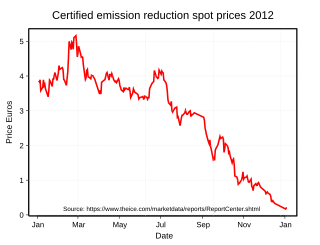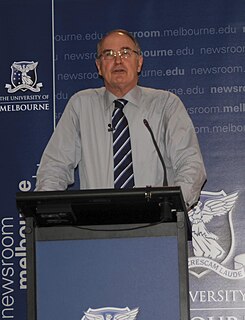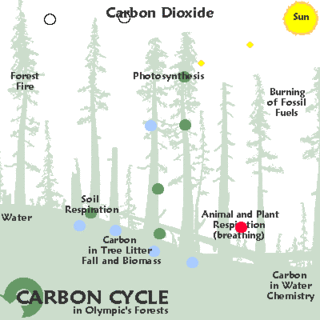
The Kyoto Protocol is an international treaty which extends the 1992 United Nations Framework Convention on Climate Change (UNFCCC) that commits state parties to reduce greenhouse gas emissions, based on the scientific consensus that (part one) global warming is occurring and (part two) that human-made CO2 emissions are driving it. The Kyoto Protocol was adopted in Kyoto, Japan, on 11 December 1997 and entered into force on 16 February 2005. There are currently 192 parties (Canada withdrew from the protocol, effective December 2012) to the Protocol.

Emissions trading is a market-based approach to controlling pollution by providing economic incentives for reducing the emissions of pollutants.
Environmental finance is a field within finance that employs market-based environmental policy instruments to improve the ecological impact of investment strategies. The primary objective of environmental finance is to regress the negative impacts of climate change through pricing and trading schemes. The field of environmental finance was established in response to the poor management of economic crises by government bodies globally. Environmental finance aims to reallocate a businesses resources to improve the sustainability of investments whilst also retaining profit margins.
A carbon credit is a generic term for any tradable certificate or permit representing the right to emit one tonne of carbon dioxide or the equivalent amount of a different greenhouse gas (tCO2e).

The Clean Development Mechanism (CDM) is one of the Flexible Mechanisms defined in the Kyoto Protocol that provides for emissions reduction projects which generate Certified Emission Reduction units (CERs) which may be traded in emissions trading schemes. The market crashed in 2012 when the value of credits collapsed and thousands of projects were left with unclaimed credits. The struggle about what to do with the old credits sank the 2019 COP 25 in Madrid.

The European Union Emissions Trading System (EU ETS), was the first large greenhouse gas emissions trading scheme in the world, and remains the biggest. It was launched in 2005 to fight global warming and is a major pillar of EU energy policy. As of 2013, the EU ETS covers more than 11,000 factories, power stations, and other installations with a net heat excess of 20 MW in 31 countries—all 27 EU member states plus Iceland, Norway, Liechtenstein and United Kingdom. In 2008, the installations regulated by the EU ETS were collectively responsible for close to half of the EU's anthropogenic emissions of CO2 and 40% of its total greenhouse gas emissions. By 2020 the EU hopes to cut greenhouse gas emissions by 20% compared with 1990 and to increase energy efficiency by 20%. A 2020 study estimated that the EU ETS had reduced CO2 emissions by more than 1 billion tons between 2008 and 2016 or 3.8% of total EU-wide emissions.
The economics of climate change concerns the economic aspects of climate change; this can inform policies that governments might consider in response. A number of factors make this and the politics of climate change a difficult problem: it is a long-term, intergenerational problem; benefits and costs are distributed unequally both within and across countries; and both scientific and public opinions need to be taken into account.
Flexible mechanisms, also sometimes known as Flexibility Mechanisms or Kyoto Mechanisms, refers to Emissions Trading, the Clean Development Mechanism and Joint Implementation. These are mechanisms defined under the Kyoto Protocol intended to lower the overall costs of achieving its emissions targets. These mechanisms enable Parties to achieve emission reductions or to remove carbon from the atmosphere cost-effectively in other countries. While the cost of limiting emissions varies considerably from region to region, the benefit for the atmosphere is in principle the same, wherever the action is taken.

A carbon price — the method widely agreed to be the most efficient way for nations to reduce global warming emissions — is a cost applied to carbon pollution to encourage polluters to reduce the amount of greenhouse gases they emit into the atmosphere: it usually takes the form either of a carbon tax or a requirement to purchase permits to emit, generally known as carbon emissions trading, but also called "allowances".

The Carbon Pollution Reduction Scheme was a cap-and-trade emissions trading scheme for anthropogenic greenhouse gases proposed by the Rudd government, as part of its climate change policy, which had been due to commence in Australia in 2010. It marked a major change in the energy policy of Australia. The policy began to be formulated in April 2007, when the federal Labor Party was in Opposition and the six Labor-controlled states commissioned an independent review on energy policy, the Garnaut Climate Change Review, which published a number of reports. After Labor won the 2007 federal election and formed government, it published a Green Paper on climate change for discussion and comment. The Federal Treasury then modelled some of the financial and economic impacts of the proposed CPRS scheme.

Ross Gregory Garnaut is an Australian economist, currently serving as a vice-chancellor's fellow and professorial fellow of economics at the University of Melbourne. He is the author of numerous publications in scholarly journals on international economics, public finance and economic development, particularly in relation to East Asia and the Southwest Pacific.
Carbon emissions trading is a form of emissions trading that specifically targets carbon dioxide (calculated in tonnes of carbon dioxide equivalent or tCO2) and it currently constitutes the bulk of emissions trading.

Climate change mitigation scenarios are possible futures in which global warming is reduced by deliberate actions, such as a comprehensive switch to energy sources other than fossil fuels. These are actions that minimize emissions so atmospheric greenhouse gas concentrations are stabilized at levels that restrict the adverse consequences of climate change. Using these scenarios, the examination of the impacts of different carbon prices on an economy is enabled within the framework of different levels of global aspirations.
Greenhouse gas emissions by Australia totalled 533.36 million tonnes CO
2-equivalent based on Greenhouse Gas national inventory report data for 2019; representing per capita CO2e emissions of 21.03 tons. Australia uses principally coal power for electricity but this is rapidly decreasing with a growing share of renewables making up the energy supply mix, and most existing coal-fired power station scheduled to cease operation between 2022-2048. Emissions by the country have started to fall and are expected to continue to fall in coming years as more renewable projects come online.

The New Zealand Emissions Trading Scheme is a partial-coverage all-free allocation uncapped highly internationally linked emissions trading scheme. The NZ ETS was first legislated in the Climate Change Response Amendment Act 2008 in September 2008 under the Fifth Labour Government of New Zealand and then amended in November 2009 and in November 2012 by the Fifth National Government of New Zealand.

Biosequestration is the capture and storage of the atmospheric greenhouse gas carbon dioxide by continual or enhanced biological processes.
The Climate Change Response Amendment Act 2008 was a statute enacted in September 2008 by the Fifth Labour Government of New Zealand that established the first version of the New Zealand Emissions Trading Scheme, a national all-sectors all-greenhouse gases uncapped and highly internationally linked emissions trading scheme.

The Clean Energy Act 2011 was an Act of the Australian Parliament, the main Act in a package of legislation that established an Australian emissions trading scheme (ETS), to be preceded by a three-year period of fixed carbon pricing in Australia designed to reduce carbon dioxide emissions as part of efforts to combat global warming.
A carbon pricing scheme in Australia was introduced by the Gillard Labor minority government in 2011 as the Clean Energy Act 2011 which came into effect on 1 July 2012. Emissions from companies subject to the scheme dropped 7% upon its introduction. As a result of being in place for such a short time, and because the then Opposition leader Tony Abbott indicated he intended to repeal "the carbon tax", regulated organisations responded rather weakly, with very few investments in emissions reductions being made. The scheme was repealed on 17 July 2014, backdated to 1 July 2014. In its place the Abbott Government set up the Emission Reduction Fund in December 2014. Emissions thereafter resumed their growth evident before the tax.
South Korea’s Emissions Trading Scheme(KETS) is the second largest in scale after the European Union Emission Trading Scheme and was launched on January 1, 2015. South Korea is the second country in Asia to initiate a nationwide carbon market after Kazakhstan. Complying to the country’s pledge made at the Copenhagen Accord of 2009, the South Korean government aims to reduce its greenhouse gas (GHG) emissions by 30% below its business as usual scenario by 2020. They have officially employed the cap-and-trade system and the operation applies to over 525 companies which are accountable for approximately 68% of the nation’s GHG output. The operation is divided up into three periods. The first and second phases consist of 3 years each, 2015 to 2017 and 2018 to 2020. The final phase will spread out over the next 5 years from 2021 to 2025.










